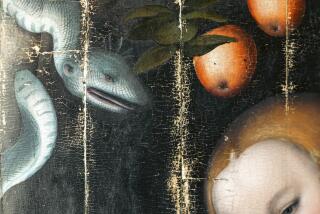C. Gregory Stapko, 92; Painter, Restorer Excelled at Copying Famous Works of Art
- Share via
C. Gregory Stapko, a portrait painter, painting restorer and the nation’s foremost copyist of famous works of art, died of cancer at his home in McLean, Va., on March 12. He was 92.
His copies of famous works, many from the National Gallery of Art, hang in the White House, Blair House, Arlington House, U.S. embassies and government agencies, as well as the walls of businesses and private homes around the world.
Stapko’s career as a copyist began in 1941, when he was newly arrived in Washington from Milwaukee. He discovered that he could lug his paints and easel into the National Gallery, set up in front of a painting on the wall and spend hours perfecting his technique by making a copy.
As his son, Christopher Stapko, tells the story, an antiques dealer saw a copy the elder Stapko had made of Pierre-Auguste Renoir’s “A Girl With a Watering Can” and assured him that he could sell it. Stapko, short on cash, sold him the copy, which ended up in the dealer’s shop window.
Not long afterward, as the son recounts the story, “goons in trench coats” came to his house, bundled him into a car and hustled him to a basement office of the National Gallery, where John Walker III, then chief curator, and other gallery personnel waited for him in a state of high anxiety.
“Do you know what you have done to me?” an angry Walker asked. “Because of you, I’ve been accused of releasing these paintings to an antiques dealer for public sale.”
Stapko’s copying genius led to a new gallery rule requiring that all copies had to be done at least two inches smaller than the original and labeled on the back with paint that would stand out under X-rays long after the color had faded. It also led to Stapko’s years-long association with the National Gallery of Art.
“Copying is a definite field in art, and it calls for much study and a mastery of techniques,” Stapko told the Philadelphia Evening Bulletin in 1947, shortly after being commissioned to make a copy of Gilbert Stuart’s full-length “Lansdowne” portrait of George Washington for the U.S. Embassy in London.
It usually took Stapko a week or two to make his copies. At the height of his career, he was turning out 50 to 70 works a year, both copies and originals.
Casimir Gregory Stapko was born in Milwaukee to Polish immigrants. He hated school and dropped out after seventh grade. At 13, he was apprenticed to various church painters, who taught him to restore frescoes, imitate marble and wood, paint murals and apply gold leaf. At 18, he started his own house-painting business with 40 helpers, many of them teenage alumni of the local reform school.
With the outbreak of World War II, most of his young helpers and skilled craftsmen enlisted or were drafted, so Stapko, rejected by the draft board, shut down the business. He moved to Washington at the urging of Polish artist Eliasz Kanarek, who operated a studio and had prominent connections that would lead to portrait commissions for his protege, Stapko.
In addition to portrait painting and copying assignments, Stapko restored damaged paintings, taught oil painting, did gold-leaf work for churches, built furniture and crafted copies of old frames to go with copied paintings. He also copied paintings for publishers of illustrated art books.
Stapko’s wife, Isabel Wetherill Stapko, a painter and textile artist, died in 1998.
Survivors include his children, Kamila Stapko Allen of Toronto, Ohio; John F. Stapko of Laurel, Md.; Gregory W. Stapko of Big Bear City; Joseph S. Stapko of Berryville, Va.; Christopher C. Stapko of Alexandria, Va.; and Michael D. Stapko of Ontario, Calif.; a sister; and eight grandchildren.
More to Read
The biggest entertainment stories
Get our big stories about Hollywood, film, television, music, arts, culture and more right in your inbox as soon as they publish.
You may occasionally receive promotional content from the Los Angeles Times.










